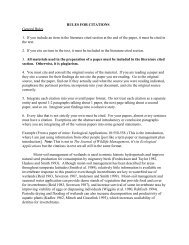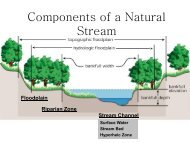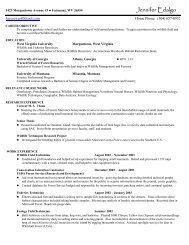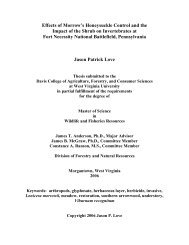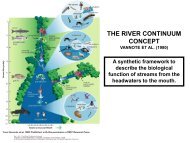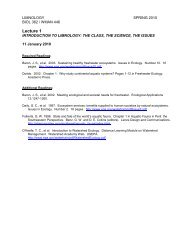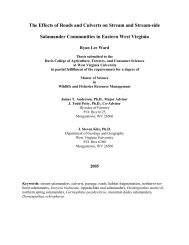An Experimental Study of Vertical Habitat Use and Habitat Shifts in ...
An Experimental Study of Vertical Habitat Use and Habitat Shifts in ...
An Experimental Study of Vertical Habitat Use and Habitat Shifts in ...
You also want an ePaper? Increase the reach of your titles
YUMPU automatically turns print PDFs into web optimized ePapers that Google loves.
not<strong>in</strong>g that the abundance <strong>of</strong> some species is more susceptible to, <strong>and</strong> thus regulated by,<br />
environmental factors (Freeman et al. 1988). This is ma<strong>in</strong>ly due to morphological<br />
features <strong>and</strong> the ability <strong>of</strong> benthic fish to hold position more efficiently than water<br />
column species dur<strong>in</strong>g <strong>in</strong>creased flow. There is no doubt an abundance <strong>of</strong> <strong>in</strong>stances<br />
where environmental conditions have disallowed <strong>in</strong>troduced species to colonize new<br />
environments. However, it is very difficult to document an attempt at colonization by a<br />
species if that species fails to become established before its presence can be recorded<br />
(Williamson <strong>and</strong> Fitter 1996).<br />
Suitable habitat availability can determ<strong>in</strong>e whether or not a species becomes<br />
established <strong>and</strong> persists <strong>in</strong> a new environment (Courtenay <strong>and</strong> Hensley 1980).<br />
Competitors will eventually exclude one another from habitats that are homogeneous<br />
with respect to a limit<strong>in</strong>g resource (Dueser <strong>and</strong> Porter 1986, Murray 1986). The number<br />
<strong>of</strong> fish species an aquatic system can hold at equilibrium depends greatly on habitat size<br />
<strong>and</strong> complexity (Harper et al. 1961, Magnuson 1976). For example, <strong>in</strong>creased<br />
environmental variability has been correlated with a decrease <strong>in</strong> niche overlap <strong>in</strong><br />
sympatric desert lizard species (Pianka 1974). <strong>Habitat</strong> complexity is <strong>of</strong>ten lower <strong>in</strong> small<br />
aquatic environments than <strong>in</strong> large ones. Increased susceptibility to local ext<strong>in</strong>ctions is a<br />
common result <strong>of</strong> this phenomenon (Magnuson 1976). With respect to <strong>in</strong>troduced<br />
species, m<strong>and</strong>atory habitat characteristics may already be utilized or completely absent <strong>in</strong><br />
the host environment. Thus, if an <strong>in</strong>troduced species requires a particular habitat<br />
characteristic colonization may not be feasible <strong>in</strong> the new area.<br />
Low watershed connectivity or the degree <strong>of</strong> geographical isolation can limit the<br />
ease <strong>of</strong> which an <strong>in</strong>vasive species can reach a particular stream segment through natural<br />
6



